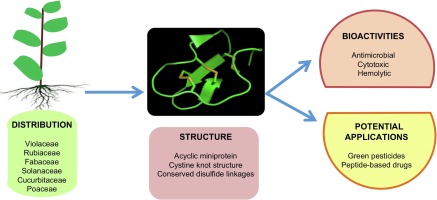当前位置:
X-MOL 学术
›
Phytochemistry
›
论文详情
Our official English website, www.x-mol.net, welcomes your
feedback! (Note: you will need to create a separate account there.)
An overview of acyclotides: Past, present and future
Phytochemistry ( IF 3.2 ) Pub Date : 2020-02-01 , DOI: 10.1016/j.phytochem.2019.112215 Ramya Tammineni 1 , Pooja Gulati 2 , Sanjay Kumar 2 , Aparajita Mohanty 3
Phytochemistry ( IF 3.2 ) Pub Date : 2020-02-01 , DOI: 10.1016/j.phytochem.2019.112215 Ramya Tammineni 1 , Pooja Gulati 2 , Sanjay Kumar 2 , Aparajita Mohanty 3
Affiliation

|
Acyclotides are plant-based, acyclic miniproteins with cystine knot motif formed by three conserved disulfide linkages and lack head to tail ligation. Acyclotides may not necessarily be less stable, even though they lack cyclic backbone, as the conserved cystine knot feature provides the required stability. Violacin A was the first acyclotide, isolated from Viola odorata in 2006. Until now, acyclotides have been reported from five dicot families (Violaceae, Rubiaceae, Cucurbitaceae, Solanaceae, Fabaceae) and one monocot family (Poaceae). In Poaceae, only acyclotides have been found whereas in dicot families both cyclotides and acyclotides have been isolated. In last 15 years, several acyclotides with antimicrobial, cytotoxic and hemolytic bioactivities have been discovered. Thus, although many naturally expressed acyclotides do exhibit bioactivities, the linearization of the cyclic peptides may result in loss of bioactivities. Although, bioactivities of acyclotides are comparable to their cyclic counterparts, the numbers of isolated acyclotides are still few. Further, those discovered, have the scope to be screened for agriculturally important activities (insecticidal, anti-helminthic, molluscicidal) and pharmaceutical properties (anticancer, anti-HIV, immuno-stimulant). The feasibility of application of acyclotides is because of their relatively less complex biological synthesis compared to cyclotides, as the cyclization step is not needed. This attribute facilitates the production of transgenic crops and/or its expression in heterologous organisms, lacking cyclization machinery. Keeping in view the bioactivities and the wide array of emerging potential applications of acyclotides, the present review discusses their distribution in plants, gene and protein structure, biosynthesis, bioactivities and mechanism of action. Further, their potential applications and future perspectives to exploit them in agriculture and pharmaceutical industries have been highlighted.
中文翻译:

acyclotides 概述:过去、现在和未来
Acyclotides 是基于植物的无环小蛋白,具有由三个保守的二硫键形成的胱氨酸结基序,没有头对尾连接。Acyclotides 可能不一定不太稳定,即使它们缺乏环状骨架,因为保守的胱氨酸结特征提供了所需的稳定性。Violacin A 是第一个 acyclotide,于 2006 年从 Viola odorata 中分离出来。到目前为止,已经报道了来自五个双子叶植物科(紫罗兰科、茜草科、葫芦科、茄科、豆科)和一个单子叶植物科(禾本科)的 acyclotide。在禾本科中,只发现了 acyclotides,而在双子叶植物科中,已经分离到了 cyclotides 和 acyclotides。在过去的 15 年中,已经发现了几种具有抗菌、细胞毒性和溶血生物活性的无环素。因此,尽管许多天然表达的无环肽确实表现出生物活性,但环肽的线性化可能会导致生物活性的丧失。虽然,acyclotides 的生物活性与其环状对应物相当,但分离出的 acyclotides 的数量仍然很少。此外,所发现的那些具有重要的农业活性(杀虫、抗蠕虫、杀软体动物)和药物特性(抗癌、抗 HIV、免疫刺激剂)的筛选范围。应用无环肽的可行性是因为与环肽相比,它们的生物合成相对不太复杂,因为不需要环化步骤。这种属性有助于转基因作物的生产和/或其在异源生物中的表达,缺乏环化机制。考虑到无环苷酸的生物活性和广泛的新兴潜在应用,本综述讨论了它们在植物中的分布、基因和蛋白质结构、生物合成、生物活性和作用机制。此外,还强调了它们在农业和制药行业中的潜在应用和未来前景。
更新日期:2020-02-01
中文翻译:

acyclotides 概述:过去、现在和未来
Acyclotides 是基于植物的无环小蛋白,具有由三个保守的二硫键形成的胱氨酸结基序,没有头对尾连接。Acyclotides 可能不一定不太稳定,即使它们缺乏环状骨架,因为保守的胱氨酸结特征提供了所需的稳定性。Violacin A 是第一个 acyclotide,于 2006 年从 Viola odorata 中分离出来。到目前为止,已经报道了来自五个双子叶植物科(紫罗兰科、茜草科、葫芦科、茄科、豆科)和一个单子叶植物科(禾本科)的 acyclotide。在禾本科中,只发现了 acyclotides,而在双子叶植物科中,已经分离到了 cyclotides 和 acyclotides。在过去的 15 年中,已经发现了几种具有抗菌、细胞毒性和溶血生物活性的无环素。因此,尽管许多天然表达的无环肽确实表现出生物活性,但环肽的线性化可能会导致生物活性的丧失。虽然,acyclotides 的生物活性与其环状对应物相当,但分离出的 acyclotides 的数量仍然很少。此外,所发现的那些具有重要的农业活性(杀虫、抗蠕虫、杀软体动物)和药物特性(抗癌、抗 HIV、免疫刺激剂)的筛选范围。应用无环肽的可行性是因为与环肽相比,它们的生物合成相对不太复杂,因为不需要环化步骤。这种属性有助于转基因作物的生产和/或其在异源生物中的表达,缺乏环化机制。考虑到无环苷酸的生物活性和广泛的新兴潜在应用,本综述讨论了它们在植物中的分布、基因和蛋白质结构、生物合成、生物活性和作用机制。此外,还强调了它们在农业和制药行业中的潜在应用和未来前景。











































 京公网安备 11010802027423号
京公网安备 11010802027423号